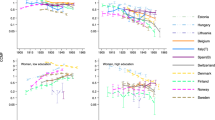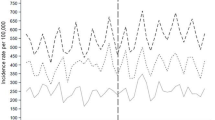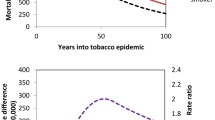Abstract
Socioeconomic inequalities in health and mortality remain a widely recognized problem. Countries with smaller inequalities in smoking have smaller inequalities in mortality, and smoking plays an important part in the explanation of inequalities in some countries. We identify the potential for reducing inequalities in all-cause and smoking-related mortality in 19 European populations, by applying different scenarios of smoking exposure. Smoking prevalence information and mortality data come from 19 European populations. Prevalence rates are mostly taken from National Health Surveys conducted around the year 2000. Mortality rates are based on country-specific longitudinal or cross-sectional datasets. Relative risks come from the Cancer Prevention Study II. Besides all-cause mortality we analyze several smoking-related cancers and chronic obstructive pulmonary disease/asthma. We use a newly-developed tool to quantify the changes in population health potentially resulting from modifying the population distribution of exposure to smoking. This tool is based on the epidemiological measure of the population attributable fraction, and estimates the impact of scenario-based distributions of smoking on educational inequalities in mortality. The potential reduction of relative inequality in all-cause mortality between those with high and low education amounts up to 26 % for men and 32 % for women. More than half of the relative inequality may be reduced for some causes of death, often in countries of Northern Europe and in Britain. Patterns of potential reduction in inequality differ by country or region and sex, suggesting that the priority given to smoking as an entry-point for tackling health inequalities should differ between countries.

Similar content being viewed by others
References
Cavelaars AE, Kunst AE, Geurts JJ, Crialesi R, Grotvedt L, et al. Educational differences in smoking: international comparison. BMJ. 2000;320:1102–7.
Giskes K, Kunst AE, Benach J, Borrell C, Costa G, et al. Trends in smoking behaviour between 1985 and 2000 in nine European countries by education. J Epidemiol Community Health. 2005;59:395–401.
Kulik MC, Menvielle G, Eikemo TA, Bopp M, Jasilionos D. et al. Educational inequalities in three smoking-related causes of death in 18 European populations. Nicotine Tob Res. 2013; in press.
Huisman M, Kunst AE, Mackenbach JP. Educational inequalities in smoking among men and women aged 16 years and older in 11 European countries. Tob Control. 2005;14:106–13.
Laaksonen M, Rahkonen O, Karvonen S, Lahelma E. Socioeconomic status and smoking: analysing inequalities with multiple indicators. Eur J Public Health. 2005;15:262–9.
Mackenbach JP, Stirbu I, Roskam AJ, Schaap MM, Menvielle G, et al. Socioeconomic inequalities in health in 22 European countries. N Engl J Med. 2008;358:2468–81.
Stringhini S, Dugravot A, Shipley M, Goldberg M, Zins M, et al. (2011) Health behaviours, socioeconomic status, and mortality: further analyses of the British Whitehall II and the French GAZEL prospective cohorts. PLoS Med 8:e1000419.
Huisman M, Kunst AE, Bopp M, Borgan JK, Borrell C, et al. Educational inequalities in cause-specific mortality in middle-aged and older men and women in eight western European populations. Lancet. 2005;365:493–500.
Mackenbach JP, Huisman M, Andersen O, Bopp M, Borgan JK, et al. Inequalities in lung cancer mortality by the educational level in 10 European populations. Eur J Cancer. 2004;40:126–35.
Van der Heyden JH, Schaap MM, Kunst AE, Esnaola S, Borrell C, et al. Socioeconomic inequalities in lung cancer mortality in 16 European populations. Lung Cancer. 2009;63:322–30.
Thun M, Peto R, Boreham J, Lopez AD. Stages of the cigarette epidemic on entering its second century. Tob Control. 2012;21:96–101.
Lopez AD, Collishaw NE, Piha T. A descriptive model of the cigarette epidemic in developed countries. Tob Control. 1994;3:242–7.
Amos A et al. Tobacco control, inequalities in health and action at the local level in England, Public Health Research Consortium. 2011. Retrieved March 2012 from http://phrc.lshtm.ac.uk/papers/PHRC_A9-10R_Final_Report.pdf.
Thomas S, Fayter D, Misso K, Ogilvie D, Petticrew M, et al. Population tobacco control interventions and their effects on social inequalities in smoking: systematic review. Tob Control. 2008;17:230–7.
Eurothine (2007) Tackling health inequalities in Europe: an integrated approach—EUROTHINE—final report. Retrieved March 2012 from: http://survey.erasmusmc.nl/eurothine/.
Östergren O, Menvielle G, Lundberg O (2011) Adjustment method to ensure comparability between populations reporting mortality data in different formats in the EURO-GBD-SE project. Working document. Retrieved Aug 2012 from: http://www.euro-gbd-se.eu/fileadmin/euro-gbd-se/public-files/Working%20document%20on%20the%20correction%20factor.pdf.
American Cancer Society (ACS). Unpublished estimates provided by ACS. See Thun MJ, Day-Lally C, Myers DG, et al. Trends in tobacco smoking and mortality from cigarette use in Cancer Prevention Studies I (1959 through 1965) and II (1982 through 1988). In: Changes in cigarette-related disease risks and their implication for prevention and control. Smoking and Tobacco Control Monograph 8. Bethesda, MD: US Department of Health and Human Services, Public Health Service, National Institutes of Health, National Cancer Institute 1997;305–382. NIH Publication no. 97–1213. https://apps.nccd.cdc.gov/sammec/show_risk_data.asp.
Lopez A, Mathers C, Ezzati M, editors. Chapter 4, Comparative Quantification of Mortality and Burden of Disease Attributable to Selected Risk Factors, Global Burden of Disease and Risk Factors. Washington, DC: World Bank; 2006.
Steenland K, Armstrong B. An overview of methods for calculating the burden of disease due to specific risk factors. Epidemiology. 2006;17:512–9.
Murray CJ, Ezzati M, Lopez AD, Rodgers A, Vander Hoorn S. Comparative quantification of health risks conceptual framework and methodological issues. Popul Health Metr. 2003;1:1.
Hoffmann R. Socioeconomic differences in old age mortality. Dordrecht: Springer; 2008.
Danaei G, Ding EL, Mozaffarian D, Taylor B, Rehm J, et al. The preventable causes of death in the United States: comparative risk assessment of dietary, lifestyle, and metabolic risk factors. PLoS Med. 2009;6:e1000058.
Hoffmann R. Illness, not age, is the leveler of social mortality differences in old age. J Gerontol B Psychol Sci Soc Sci. 2011;66B:374–9.
Hoffmann R, Eikemo TA, Kulhanova I, Dahl E, Deboosere P, et al. The potential impact of a social redistribution of specific risk factors on socioeconomic inequalities in mortality: illustration of a method based on population attributable fractions. J Epidemiol Community Health. 2013;67(1):56–62.
Efron B, Tibshirani RJ. An introduction to the bootstrap. New York: Chapman and Hall; 1993.
Siahpush M, Wakefield MA, Spittal MJ, Durkin SJ, Scollo MM. Taxation reduces social disparities in adult smoking prevalence. Am J Prev Med. 2009;36:285–91.
DeCicca P, McLeod L. Cigarette taxes and older adult smoking: evidence from recent large tax increases. J Health Econ. 2008;27:918–29.
Eurostat. 2009. Retrieved January 2011 from http://epp.eurostat.ec.europa.eu/statistics_explained/index.php/Comparative_price_levels_for_food,_beverages_and_tobacco.
Eurostat. 2010. Retrieved March 2012 from http://europa.eu/rapid/pressReleasesAction.do?reference=STAT/10/195&type=HTML.
Walter SD. The estimation and interpretation of attributable risk in health research. Biometrics. 1976;32:829–49.
GBD Study Operations Manual. Harvard University, University of Washington, John Hopkins University, University of Queensland, World Health Organization. 2009.
Gunning-Schepers L. The health benefits of prevention. Rotterdam: Erasmus Medical Center, Dissertation. 1998.
Rockhill B, Newman B, Weinberg C. Use and misuse of population attributable fractions. Am J Public Health. 1998;88:15–9.
General Household Survey (GSH). Time series dataset 1980/1982. Provided by the Economic and Social Data Service.
Sante et soins medicaux—1980–1981. [electronic file], INSEE [data producer], Centre Maurice Halbwachs (CMH) [data distributer]. 1992.
Main C, Thomas S, Ogilvie D, Stirk L, Petticrew M, et al. Population tobacco control interventions and their effects on social inequalities in smoking: placing an equity lens on existing systematic reviews. BMC Public Health. 2008;8:178.
Ezzati M, Hoorn SV, Lopez AD, Danaei G, Rodgers A, et al. Comparative quantification of mortality and burden of disease attributable to selected risk factors. 2006.
Mackenbach JP, Kunst AE, Lautenbach H, Oei YB, Bijlsma F. Competing causes of death: a death certificate study. J Clin Epidemiol. 1997;50:1069–77.
Cooreman J, Thom TJ, Higgins MW. Mortality from chronic obstructive pulmonary diseases and asthma in France, 1969–1983. Comparisons with the United States and Canada. Chest. 1990;97:213–9.
Mannino DM, Buist AS. Global burden of COPD: risk factors, prevalence, and future trends. Lancet. 2007;370:765–73.
EURO-GBD-SE project final report (2012). Retrieved Jan 2013 from: http://www.euro-gbd-se.eu/fileadmin/euro-gbd-se/public-files/EURO-GBD-SE_Final_report.pdf.
Stringhini S, Sabia S, Shipley M, Brunner E, Nabi H, et al. Association of socioeconomic position with health behaviors and mortality. JAMA. 2010;303:1159–66.
Laaksonen M, Talala K, Martelin T, Rahkonen O, Roos E, et al. Health behaviours as explanations for educational level differences in cardiovascular and all-cause mortality: a follow-up of 60 000 men and women over 23 years. Eur J Public Health. 2008;18:38–43.
Martikainen P, Ho JY, Preston S, Elo IT (2012) The changing contribution of smoking to educational differences in life expectancy: indirect estimates for Finnish men and women from 1971 to 2010. J Epidemiol Community Health.
Soerjomataram I, Barendregt JJ, Gartner C, Kunst A, Moller H, et al. Reducing inequalities in lung cancer incidence through smoking policies. Lung Cancer. 2011;73:268–73.
Acknowledgments
We thank the EURO-GBD-SE international project partners: Mortality data: Pekka Martikainen (Finland), Olle Lundberg (Sweden), Lisbeth Laursen (Denmark), Alaa Al-Hamad and Myer Glickman (England and Wales), Chris Dibben (Scotland), Patrick Deboosere (Belgium), Gwenn Menvielle (France), Matthias Bopp (Switzerland), Johannes Klotz (Austria), Carme Borrell (Barcelona, Spain), Santiago Esnaola (Basque Country, Spain), Enrique Regidor (Madrid, Spain), Giuseppe Costa (Turin, Italy), Annibale Biggeri (Tuscany, Italy), Jitka Rychtarikova (Czech Republic), Bogdan Wojtyniak (Poland), Domantas Jasilionis (Lithuania), Mall Leinsalu (Estonia). Risk factor prevalence data: Satu Helakorpi (Finland), Bo Burström (Sweden), Ola Ekholm (Denmark), Ken Judge (England), Chris Dibben (Scotland), J.J.M. Geurts (Netherlands), Jean Tafforeau (Belgium), Frédérique Ruchon (France), Centre Maurice Hallbawachs (France), Office Fédéral de la Statistique (Switzerland), Santiago Esnaola (Basque Country, Spain), Enrique Regidor (Spain), Giuseppe Costa (Turin, Italy), D. Dzurova (Czech Republic), Bogdan Wojtyniak (Poland), Jurate Klumbiene (Lithuania), Mare Tekkel (Estonia). The project was funded by the European Commission, through the Public Health Programme, grant agreement 20081309 and through the Netherlands Organization for Health Research and Development (ZonMw), project number 121020026.
Conflict of interest
The authors declare that they have no conflict of interest.
Author information
Authors and Affiliations
Corresponding author
Additional information
This study was conducted for the Euro-GBD-SE Consortium.
Electronic supplementary material
Below is the link to the electronic supplementary material.
Rights and permissions
About this article
Cite this article
Kulik, M.C., Hoffmann, R., Judge, K. et al. Smoking and the potential for reduction of inequalities in mortality in Europe. Eur J Epidemiol 28, 959–971 (2013). https://doi.org/10.1007/s10654-013-9860-5
Received:
Accepted:
Published:
Issue Date:
DOI: https://doi.org/10.1007/s10654-013-9860-5




